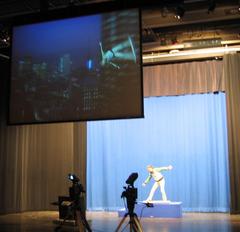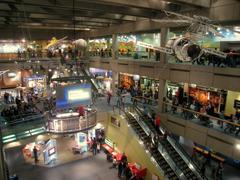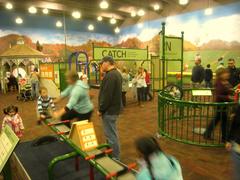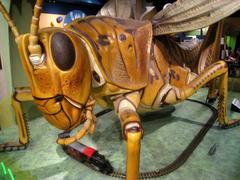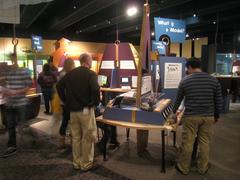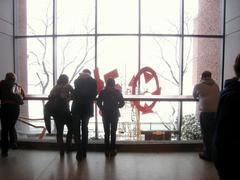
Museum of Science Boston: Visiting Hours, Tickets, and Travel Guide
Date: 14/06/2025
Introduction
Nestled along the scenic Charles River, the Museum of Science Boston is a cornerstone of scientific discovery, education, and public engagement. Established in 1830 as the Boston Society of Natural History, the museum has evolved into one of the world’s most visited science museums, drawing over 1.5 million visitors each year (Museum of Science). With more than 700 interactive exhibits across three distinct wings, signature attractions like the Charles Hayden Planetarium, and a commitment to accessibility, the museum offers an unparalleled experience for science enthusiasts, families, and tourists alike.
This comprehensive guide will help you plan your visit, covering the museum’s history, must-see exhibits, ticketing, accessibility, travel tips, and nearby Boston historical sites.
Table of Contents
- Historical Overview
- Essential Visitor Information
- Must-See Exhibits and Attractions
- Visitor Tips and FAQs
- Nearby Attractions
- Summary and Conclusion
- Sources
Historical Overview
Early Foundations: The Boston Society of Natural History (1830–1864)
The Museum of Science Boston began as the Boston Society of Natural History in 1830, a collective of passionate naturalists eager to study and share the wonders of the natural world. In its early years, the society operated from borrowed spaces until 1864, when it moved to a dedicated building in Boston’s Back Bay. This enabled expanded exhibitions, lectures, and scientific publications, cementing its place as a leading center for science education (Britannica).
Transformation into the New England Museum of Natural History (1864–1939)
With a permanent home, the institution rebranded as the New England Museum of Natural History, broadening its collections and public engagement. Throughout the late 19th and early 20th centuries, the museum became an educational hub, regularly hosting lectures, publishing scientific works, and creating interactive learning opportunities (Britannica).
The Washburn Era and the Birth of a Modern Science Museum (1939–1951)
The arrival of Bradford Washburn as director in 1939 marked a pivotal shift. Washburn prioritized hands-on learning and interactive science, leading to a new facility at Science Park in 1948. In 1951, the museum was officially renamed the Museum of Science, Boston, and opened its doors as a modern science museum, pioneering participatory exhibits and educational outreach (Open Library; Boston.com; Wheelchair Travel).
Expansion and Innovation: 1950s–Present
Since the 1950s, the museum has continually expanded its offerings:
- Charles Hayden Planetarium (1958): Advanced space science programming (The Boston Day Book; Britannica).
- Mugar Omni Theater: Five-story domed IMAX experience (The Boston Day Book).
- Interactive exhibits: Pioneered hands-on science education (Museum-Ed).
- Science-By-Mail (1988): Connected students with scientist mentors (Museum-Ed).
Today, the museum is a global leader in science engagement, offering virtual learning and accessibility programs (Museum of Science; The Boston Day Book).
Essential Visitor Information
Museum of Science Boston Visiting Hours and Location
- Address: 1 Science Park, Boston, MA 02114 (Museum of Science)
- Regular Hours: Daily, 9:00 AM – 5:00 PM (extended hours on select days)
- Check the official website for special event hours and holiday closures
Museum of Science Boston Tickets and Admission
- Adults (13–64): $29
- Seniors (65+), Students: $27
- Children (3–12): $24
- Children under 3: Free
- Members: Free
- Add-ons: Charles Hayden Planetarium and Mugar Omni Theater shows require additional tickets (typically $8–$10 each)
- Discounts: Available for Boston residents, military, and groups; CityPASS and membership programs also offer benefits
Reserve timed tickets online in advance, especially during weekends and school vacations.
Getting There and Accessibility
- Public Transit: MBTA Green Line, Science Park/West End Station is adjacent (Carltonaut’s Travel Tips)
- Parking: On-site garage ($10–$22), limited availability—public transit is recommended
- Biking & Rideshare: Bike racks available; easily accessible via taxi, Uber, Lyft
- Accessibility: Fully wheelchair accessible, with elevators, ramps, accessible bathrooms, wheelchairs for loan, assistive listening devices, and sensory-friendly resources (Wheelchair Travel; Museum of Science)
Exhibit Wings and Layout
The museum is organized into three primary wings—Red, Green, and Blue—each with unique themes and experiences (mommypoppins.com; Condé Nast Traveler).
Red Wing
- Atrium and Audiokinetic Sculpture: Lively entrance with kinetic art and musical SoundStairs
- Mugar Omni Theater: New England’s only domed IMAX theater with immersive science films (trolleytours.com)
Green Wing
- Hall of Human Life: Interactive biology and health exhibits (citypass.com)
- Live Animal Care Center: Observe animal care and daily presentations (wikipedia.org)
- Butterfly Garden (Seasonal): Walk among free-flying butterflies in a lush environment (mos.org)
Blue Wing
- Theater of Electricity: World’s largest Van de Graaff generator and dramatic “Lightning!” shows (trolleytours.com)
- Engineering Design Workshop: Hands-on engineering and design challenges (mos.org)
- Mathematica: Explore math concepts through interactive Eames-designed displays (mos.org)
Charles Hayden Planetarium
A state-of-the-art planetarium with daily shows on astronomy and space, using cutting-edge projection technology (lifenewenglandstyle.com).
Artificial Intelligence Exhibit
A recent addition exploring the history, applications, and ethics of AI through interactive displays (bostonuncovered.com).
Rotating and Special Exhibitions
Temporary exhibits on topics like robotics, climate change, and space—see the events calendar for what’s on during your visit.
Live Presentations and Demonstrations
Daily science shows, from chemistry experiments to animal encounters, are scheduled throughout the museum (mos.org).
Notable Artifacts and Historical Displays
Historic computing devices, taxidermy, and artifacts mark the museum’s legacy and Boston’s boundary (wikipedia.org).
Family and Accessibility Features
Strollers, wheelchairs, family restrooms, and elevators support visitors of all ages and needs (lifenewenglandstyle.com).
Dining and Amenities
- Riverview Café: Meals and snacks with Charles River views
- Gift Shop: Science-themed toys and souvenirs (Condé Nast Traveler)
- Amenities: Lockers, free Wi-Fi, picnic tables, and lost & found (mommypoppins.com)
Visitor Tips for Must-See Attractions
- Plan for 3–4 hours: To enjoy major exhibits and a theater show (lifenewenglandstyle.com)
- Reserve theater/planetarium tickets early: Shows often sell out
- Use public transit: Avoid parking congestion
- Leverage accessibility services: For a more comfortable visit
- Check the museum’s events calendar: For special exhibitions and live presentations
Frequently Asked Questions (FAQ)
Q: What are the Museum of Science Boston visiting hours?
A: Daily, 9:00 AM to 5:00 PM. Check for extended/special hours on the official website.
Q: How much are tickets?
A: Adults $29, children (3–12) $24, seniors and students $27, under 3 free.
Q: Is the museum wheelchair accessible?
A: Yes, with elevators, ramps, and wheelchairs available (Wheelchair Travel).
Q: Are guided tours available?
A: The museum offers self-guided exploration; group tours can be arranged in advance.
Q: Can I bring food?
A: Outside food is allowed in designated outdoor areas. The Riverview Café is available inside.
Nearby Attractions and Travel Tips
- Boston Tea Party Ships & Museum
- New England Aquarium
- Freedom Trail
- Charles River Esplanade
These nearby destinations complement your museum visit and offer rich opportunities for photography, recreation, and cultural exploration (Boston.gov).
Summary of Key Points and Visitor Tips for the Museum of Science Boston
The Museum of Science Boston offers a world-class experience, blending historic legacy and modern innovation with more than 700 interactive exhibits and premier facilities like the Charles Hayden Planetarium and Mugar Omni Theater (Open Library). Its commitment to accessibility and education makes it an inclusive destination for all. Located at Science Park, with convenient transit access, and proximity to Boston’s historical sites, the museum is an essential stop for families, educators, and science enthusiasts (Boston.com; Museum of Science).
Visitor Tips:
- Purchase tickets online in advance
- Arrive early for quieter visits or to avoid crowds
- Utilize accessibility resources
- Check the events calendar for rotating exhibits and live shows
- Download the Audiala app for audio guides and interactive content
Your adventure in science and discovery awaits at this treasured Boston institution!
Sources and Official Links for the Museum of Science Boston
- Museum of Science – Britannica
- Museum of Science Boston – Official Website
- Visit Boston’s Museum of Science Like a Local – Mommy Poppins
- Guide to the Museum of Science Boston – Carltonaut’s Travel Tips
- Wheelchair Travel: Boston Attractions
- Boston Museum of Science Virtual Tour – The Boston Day Book
- What Do You Love About the Museum of Science? – Boston.com
- Museum of Science Boston – Open Library


